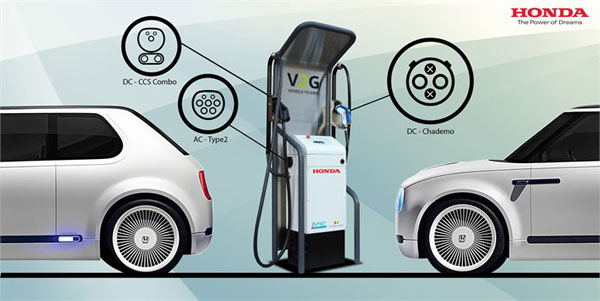• Energy can be drawn from and returned to the grid with new hardware
• New charging station is another step towards a zero-emission society
• Project is collaboration between Honda, EVTEC and The Mobility House
• Installation tests the integration of electric vehicle batteries and renewable energy sources
Honda has invested in advanced bi-directional charging technology at its European R&D site in Offenbach, Germany, which is helping to balance demand and store energy more efficiently across the facility. The new charging system incorporates renewable energy generation, and is a test bed for hardware that will be available to private households in the future.

The technology installation in Germany follows the debut of the domestic Honda Power Manager Concept at the 2017 Frankfurt Motor Show in September. The concept previewed a fully-integrated energy transfer, which takes power from the grid and can return stored energy from electric vehicle (EV) batteries – through ‘Vehicle-to-Grid’ or ‘V2G’ technology. This latest trial installation at Honda’s Offenbach site applies the same principles on a larger scale.
Through bi-directional energy transfer, electricity is drawn from the grid or is generated by photovoltaic solar panels, and is used to charge EVs plugged in to the system. While an EV is plugged in, the energy held in its battery can be transferred back to help stabilise the grid at times of short or surplus supply.
Jörg Böttcher, Vice President of Honda R&D Europe, said: “With the installation of the latest bi-directional charging technology at our R&D site in Germany, we are adding the next technology to our Smart Company project, which will further enhance our research activity in the field of zero-emission society and future mobility.”
With the help of the bi-directional hardware and with the technology of The Mobility House*, Honda aims to optimise energy management at its European R&D campus, maximising the use of renewable solar power in particular. The project is testing the interaction, compatibility and power flow between specific electrical components, including the renewable energy cells and the EV batteries. The installation represents a collaboration between Honda R&D Europe, energy service provider The Mobility House and Swiss technology company EVTEC.
The investment in the bi-directional energy transfer technology further enhances the world’s most advanced public charging station for plug-in vehicles, which was launched at Honda R&D Europe in summer 2017. Its state-of-the-art 940V capability can deliver up to 150kW of energy, enabling as many as four vehicles to charge simultaneously with different types of connectors. Since its installation in June, the EV charging station has supplied power for 447 charge sessions and has saved 3.87 tonnes of CO2.
* The Mobility House, founded in 2009, provides innovative charging and energy storage solutions to car manufacturers in over 10 countries throughout the world from its locations in Munich, Zurich and San Francisco. For further information, please visit: https://www.mobilityhouse.com/en/.



